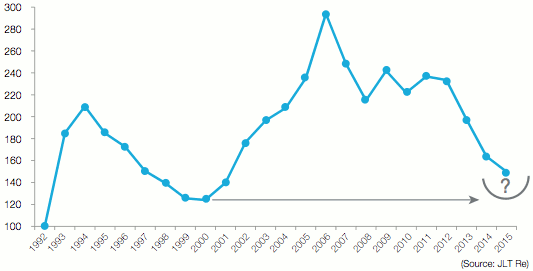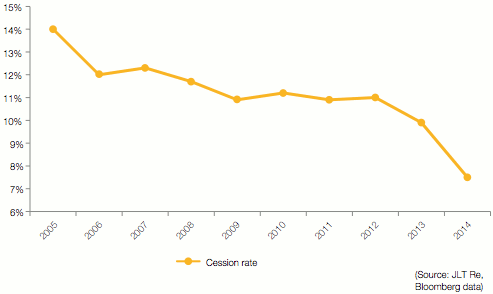Cyclical changes in the global reinsurance sector; underlined by a supply/demand imbalance, lower cessions and a wave of competition, suggests that the impact of a significant loss event would likely be restricted to one or two renewals, says JLT Re.
The persistent influx of alternative reinsurance capital from institutional and third-party investors, which gained momentum in 2011 following the financial crisis and which has intensified over the last 12 months or so, created a supply/demand imbalance in the reinsurance industry and a trend of declining pricing.
The sustained inflow of alternative reinsurance capital led to a supply and demand imbalance “greater than any seen in recent memory,” says JLT Re, claiming that the glut of supply is so great that a $130 billion loss event would likely “be restricted to one or two property-catastrophe reinsurance renewals.”
The significance of this becomes apparent when you consider the JLT Re 1 June Risk-Adjusted Property-Catastrophe ROL Index – 1992 to 2015, as depicted below.

JLT Re’s 1 June Risk-Adjusted Property-Catastrophe ROL Index – 1992 to 2015
While the above figure shows that ROLs are roughly only 20% higher than the previous cyclical low, of the late 90s, the post-event payout period lasted for several years and numerous renewal periods, peaking in 2006, as the demand for reinsurance coverage spiked in line with a series of large industry losses.
However, owing to the rich capital base that the industry currently has, and significant third-party capital on the sidelines, a significant loss event is unlikely to have any long-term positive impact on rates says JLT Re, highlighted by the recent aviation renewal period.
“This point was reinforced by recent aviation renewals following the frequency of high profile losses during the previous 18 months. Despite carriers enduring one of the costliest periods for aviation claims since 2001, competition was such that rates continued to fall,” explains JLT Re.
Despite a notable slowing of alternative reinsurance capital entering the space during the recent mid-year renewals, the growth rate of both traditional and alternative reinsurance capital between 2008 and 2014 highlights the need for a supply/demand equilibrium and the reason for falling prices for nine consecutive major reinsurance industry renewals.
JLT Re explains; “Dedicated reinsurance capital, including both traditional and alternative sources, grew by 65% between 2008 and 2014, whilst premiums increased by just 10% during the same period.”
The result of reinsurance supply outpacing demand for a prolonged period, continued benign loss activity, low interest rates and heightened competition has seen many industry analysts and experts note that stability in pricing will likely occur, but at a structurally lower level than seen before.
And now, reinsurer JLT Re has expressed a similar view, claiming that “hard markets may shorten due to the sector’s new capital structure, and cycles may change, but this has always been the case.”
Declines in demand for reinsurance have happened in the past and will happen again in the future, owing to the market’s cyclical nature, but the wealth of capacity suggests that peaks and troughs will likely be less pronounced than in previous market cycles.
The graph below from JLT Re utilising data from Bloomberg shows that the amount of reinsurance purchased by 15 of the world’s largest primary insurers has been on a decline since 2005, with a significant decrease occurring between 2013 and 2014.

Reinsurance Cession Rates of 15 Largest Global Insurers – 2005 to 2014
JLT Re says that reduced investment returns, lower pricing and a desire to lower operational costs for primary players as profitability came under pressure, enabled cession rates to drop from 14% in 2005 to 8% in 2014.
Trends witnessed throughout the reinsurance landscape in recent years and that has intensified over the last 18 months, appears to signal a change in the reinsurance pricing cycle moving forward.
In a sector that’s experienced rate declines for a prolonged series of reinsurance renewals some stability will likely be welcomed by the majority of market participants, however, it’s likely market players will have to get use to structurally lower returns than what they’ve been used to in the past and shorter payback periods.
Furthermore, as the wealth of alternative reinsurance capital further integrates and deepens its relationship with the traditional players, widely expected to remain even after a large loss event, supply will remain plentiful, resulting in a need for innovation and geographical expansion to new, underserved and emerging risks to keep demand at sustainable levels.
As we wrote a year ago: Despite capital on sideline, reinsurers expect payback. Should they?
 View all of our Artemis Live video interviews and subscribe to our podcast.
View all of our Artemis Live video interviews and subscribe to our podcast.
All of our Artemis Live insurance-linked securities (ILS), catastrophe bonds and reinsurance video content and video interviews can be accessed online.
Our Artemis Live podcast can be subscribed to using the typical podcast services providers, including Apple, Google, Spotify and more.































